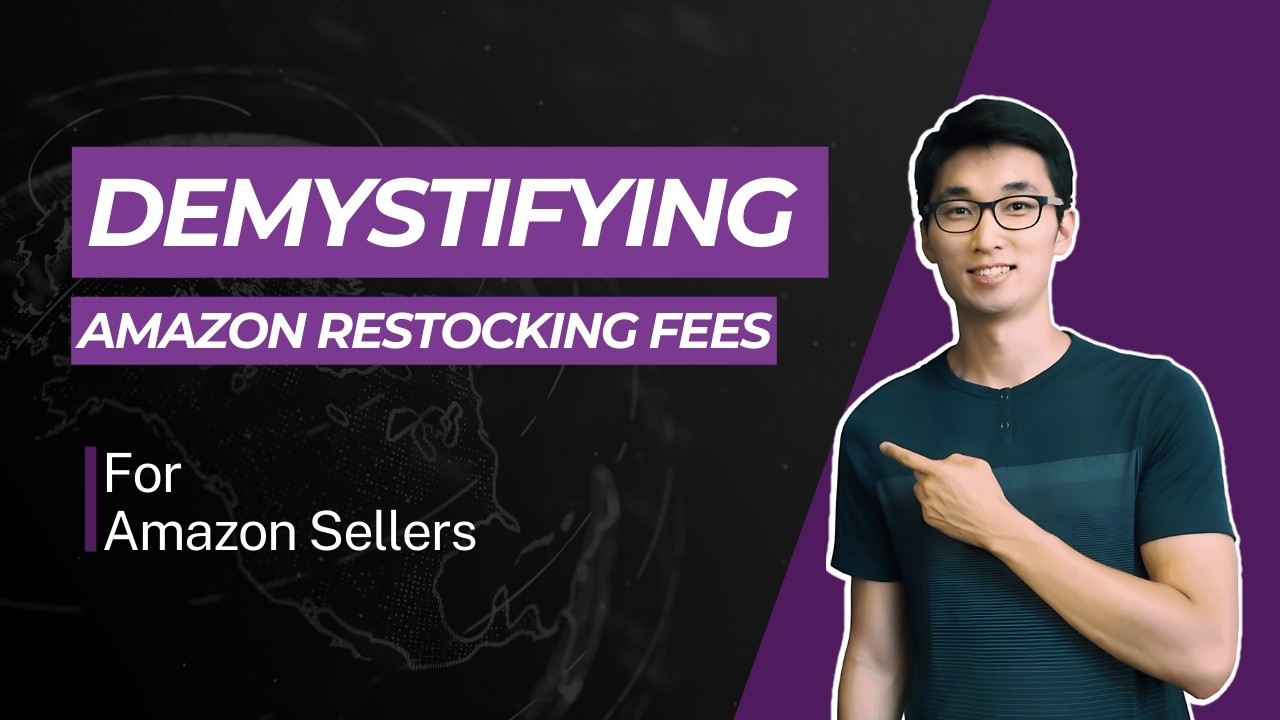Article Summary (TL;DR)
✅ Learn when you can charge restocking fees (up to 50%!) to recover expenses from unnecessary returns.
✅ Understand Amazon’s restocking fee guidelines and how to get help resolving buyer disagreements.
✅ Master calculating restocking fees based on original price and return condition to protect your bottom line.
The fees associated with an Amazon business are crucial to improving your bottom line and staying on top of your game.
Most Amazon fees are levied on sellers and take a big chunk of your profits if you don’t know how to calculate it.
We have a whole super detailed section listing every Amazon seller fee.
Amazon return request restocking fee is just one of the fees to know. When calculated correctly and knowing when and how it happens, you can save money.
The more you know, the more you can save and fatten your margins. Let’s dive into all things related to Amazon restocking fees.
Note that there are restocking fee calculator websites, but it pays to learn the fundamentals, so you can use it in disputing amazon charge fees, among other things.

What is Amazon Restocking Fees
Amazon restocking fee is a fee payable by the buyer to return products. It is calculated based on the original price of the inventory.
Depending on the inventory condition returned to you, the percentage you can charge as a restocking fee varies between 20% and 100%. However, sellers rarely qualify for a 100% restocking fee.
How Much is the Amazon Restocking Fee
Amazon restocking fee has no specific amount; it is calculated based on the original price of the goods.
The restocking fee you can charge a buyer also depends on the nature of the item and how the item was returned. In most cases and compliance with Amazon guidelines, sellers qualify for a restocking fee of up to 50%.
This information is valuable for third party sellers. Learn more about amazon 3rd party return policy and about amazon charging for return shipping.
Fees do accumulate.
When You Can Charge Amazon Restocking Fees
Amazon restocking fee doesn’t apply in all situations. According to Amazon guidelines, there are a few cases in which you qualify to charge a buyer a restocking fee.
These cases include (but are not wholly limited to):
- When a customer changes their mind after completing an order and returns the inventory in a perfect shape within the allotted 30 days return window. You can withhold up to 20% as a restocking fee for a late return where the goods are in perfect condition.
- When a customer changes their mind about an inventory and returns the inventory within the allotted or return window, you observe signs of usage or the item is damaged. In this instance, it’s within your right to charge up to 50% of the item’s original cost.
- When a customer places an order for video games and software and later changes their mind but opens the package before filing for a partial refund, while this is rare, you can charge up to a 100% restocking fee. In most cases, buyers return the product not because the product is defective.
Seller central has more details on the restocking fee guidelines.
Here’s the short version.
| Return Request | Restocking Fee |
|---|---|
| The buyer changes their mind* about a purchase and returns an item in the original condition within the return window. | No restocking fee. |
| The buyer changes their mind* about a purchase and returns an item in the original condition outside of the return window | Yes. Up to 20% of item’s price. |
| The buyer refuses delivery due to visible damage incurred during shipping or caused by the carrier. | No restocking fee. The seller pays for return shipping, but can file a claim with the carrier or insurance company, if they purchased insurance. |
| The buyer receives a used or damaged item. | No restocking fee. The seller can file a claim with the carrier or insurance company, if they purchased insurance. |
| The buyer changes their mind* about a purchase and returns a non-media item within the return window but the seller receives the item damaged or materially different than how it was originally shipped to the buyer. | Yes. Up to 50% of item’s price. |
| The buyer returns a book within the return window with obvious signs of use. | Yes. Up to 50% of item’s price. |
| The buyer returns a CD, DVD, VHS tape, , cassette tape, or vinyl record within the return window that has been opened (taken out of the plastic wrap). | Yes. Up to 50% of item’s price. |
| The buyer changes their mind* and returns open software or video games. | Yes. Up to 100% of item’s price |
| The buyer returns an item they received materially different from what they ordered. | No restocking fee. |
| Any other reason not listed here. | See About Refunds. |
If you’re in any business, you should expect several returns since customers don’t get to touch or feel a product before delivery. Not all returns qualify for a restocking fee.
This is to provide a good customer experience and make everyone happy in the value chain.
When You Can’t Charge an Amazon Restocking Fee
I believe you now know when you’re qualified for a restocking fee when a customer returns an item.
These situations are when you can’t charge a restocking fee:
- You can’t charge an Amazon restocking fee if your customer changes their mind after a purchase and returns the item within the return window in its original condition.
- You can’t charge a restocking fee if a customer returns an item because it’s defective or damaged during the shipping process. You can only file a claim with the shipping company.
- You do not qualify for a restocking fee if the customer receives a product different from what they ordered. For example, a customer ordered a blue item but instead got a red one.
These cases can be frustrating for the average seller. The thought of having to provide a full refund to your customers for no fault of yours is better imagined than experienced.
How Do I Calculate the Amazon Restocking Fee
The best way to calculate the Amazon restocking fee is to factor in the correlated fee and the reason for the return before deducting the fee from the refund amount.
You should do this within two days after receiving a return notice.
The range of the restocking cost is 20% to 100%. The majority of Amazon sellers are eligible for a restocking fee of up to 50%, however most cases do not qualify for that entire percentage.
The following formula can also be used to determine the restocking fees:
- Restocking Fee = (Purchasing Price * Restocking Percentage)/100
How to Charge a Restocking Fee on Amazon
Follow this process to collect a restocking fee from your customers:
- Go to the “Orders” tab in Seller Central and select “Manage Orders” to locate the order you want to refund.
- Click the “Refund” order in the Action column. You can also click on the “Order ID” tab on the Order Details page to refund the order.
- Click the Refund button to issue a refund.
- Select the return reason and enter the amount in the “Amount to refund” column.
- Here, you can add a note to the buyer.
- Click the Submit button to issue the refund or accept returns.
Submitting a refund request will close the buyer’s return request. Leave up to 15 minutes for the data to be updated. You can reach out to the buyer in the Orders menu if you like.
There’s also an option for the buyer to open a new request for the remaining amount.
How Does Amazon Handle Restocking Fee Disputes
If you find yourself in a dispute with a buyer regarding restocking fees, Amazon offers an opportunity to resolve the impasse quickly.
You may have to reach out to Amazon’s customer service to explain your situation and the team will swing into action to help you handle the issue most professionally.
As a seller, you’ll file the relevant documents or paperwork for the team to analyze. The review team is usually in its judgment so that both the seller and buyer will be happy at the end of the day.
It might take a few days or weeks for the review team to conclude their work.
Final Thoughts
Amazon’s return policy is supposed to protect sellers against unwarranted returns. But these restocking fees provide a way to recover some of the lost expenses if a buyer wants to return a product without a valid reason.
Depending on the state of the returned inventory, you could charge a restocking fee between 20% and 100%. But getting 100% is rare.
So, as you look forward to expanding your Amazon business, if you receive a damaged return from buyers, be bold enough to withhold part of the refund after calculating the restock fee using the original price of the inventory.
It is within your right to withhold a part of the money as stated in the Amazon return policy.
Frequently Asked Questions
How do you get out of restocking fees? Does Amazon charge restocking fee?
One of the best ways to get out of restocking fees is to find out the restocking fee policy before placing a buying order.
In other words, find out from the merchant you intend to do business with how long you have to return a product or an inventory without incurring any financial penalties.
Why do I pay restocking fees?
You are subjected to the restocking fee to keep prices and costs down when dealing with returned and not defective products.
Remember, there are many costs associated with processing orders, so when a buyer places an order and returns the goods, the retailer or seller will have to spend more to handle the return.
Can I dispute the restocking fees?
Certainly, if you find out that there is a discrepancy in the restocking fee charged when goods are returned, you can reach out to Amazon to submit a complaint, and Amazon will help you mediate between you and the retailer or merchant.
Are restocking fees illegal?
Amazon restocking fees are not illegal, only that the laws about them differ from one state to the other.
However, the restocking fee is illegal if:
– The goods are defective.
– The restock fee was not clear enough from the beginning of the deal.
– The fee is over 50% of the product price.
– Sellers fail to deliver goods at the specified time.
– Sellers ship the wrong inventory.
How much can a seller charge for Amazon restocking fees?
The amount you can charge as a restocking fee should be between 20% and 50% of the original product price.
For example, if a buyer requests a product return, you can withhold up to 50% of the product’s price as a restocking fee, provided the product is not damaged.
Comments
2 responses to “Amazon Restocking Fee Explained: A Complete Guide to Navigating Restocking Fees with Confidence”
-
I was sent a package of Christmas cards that I never ordered. Check my credit cards and no charges made. I don’t want the cards. How do I send them back?
-
🙂 Amazon sellers are using your address to fake orders.
-
Related Posts

10 Profitable Product Categories for Amazon Affiliates 2025
What you’ll learn Amazon is a favorite for experienced and…

Unlock the Secret to a Profitable Automated Amazon Store: How to Build a Hands-Free Income Stream
Ever dreamed of running a profitable Amazon business while sipping…

Master Amazon New Restricted Keywords: A Seller’s Guide to Success
Changes to Amazon’s restricted keywords list have taken a lot…






Leave a Reply